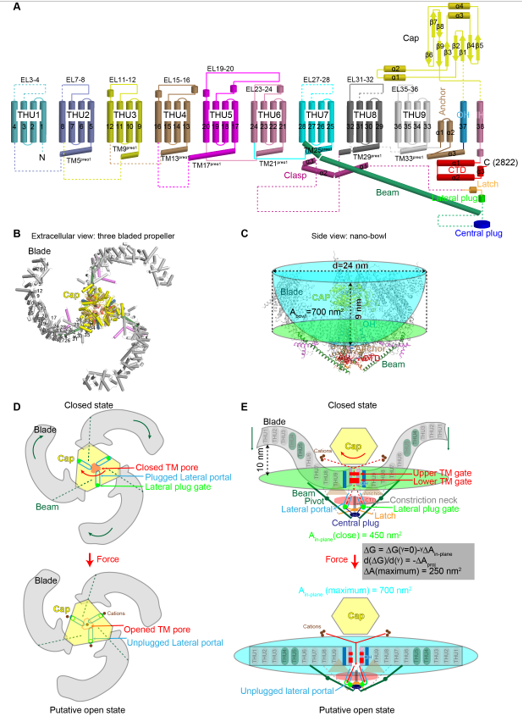个人简历
肖百龙博士于2001年从中山大学生命科学学院生物化学专业获得理学学士学位;2001-2006年在加拿大卡尔加里大学(University of Calgary)师从Wayne Chen教授获得心血管分子生物学方向博士学位;2007-2012年在美国斯克利普斯研究所(The Scripps Research Institute) 师从Ardem Patapoutian教授,从事神经科学博士后研究。现任清华大学药学院副院长,其自2013年起任职于清华大学药学院、清华-北大生命科学联合中心及IDG/麦戈文脑科学研究院,担任研究员和博士生导师,主持(过)国家杰出青年科学基金、国家优秀青年科学基金、重点项目、面上项目以及及国家重大研究计划等多项科研项目。过去20年一直致力于离子通道研究,以第一作者与通讯作者(含共同)身份在Nature(4篇Article),Neuron(3篇),Nature Neuroscience,Nature Chemical Biology,Nature Communications(3篇),Cell Research, Circulation Research (2篇),Annual Review of Pharmacology and Toxicology, Trends in Biochemical Sciences等高水平期刊发表论文28篇,期中2篇被收录进神经生物学教科书。
研究方向
机械门控阳离子通道作为机械力分子受体承担将机械力刺激转化为生物电化学信号的功能,决定触觉、痛觉、本体觉、内脏觉、血压调节、心脏搏动、骨的生成与重塑等基本生命活动。但是由于这类通道在哺乳动物中的分子组成及机制长期未被了解,导致对其所介导的生物机械传感机制的研究和理解远落后于由配体或电压门控离子通道所介导的化学或电信号传感机制的理解。
进化上高度保守的Piezo通道家族是在哺乳动物中所鉴定发现并被确证的首类机械门控阳离子通道 (Coste B. et al., Science 2010; Coste B*. and Xiao B*. et al. Nature 2012)。我们综合利用生化结构、电生理膜片钳、高通量药物筛选、转基因小鼠模型以及人类遗传学等多学科研究手段,聚焦于从分子、细胞及动物水平解答Piezo通道如何将机械力刺激转化为电化学信号并决定其相关的生理病理功能这一核心科学问题,并致力于开发以Piezo通道为靶点的新型药物及技术。
具体研究方向包括:1)从原子级别空间尺度、毫秒级别时间尺度、皮安级别电流尺度以及皮牛级别力学尺度,深入探究Piezo通道的动态机械门控机制以及调控机制;2)揭示Piezo 通道如何利用其生物物理特性决定其重要的生理病理功能;3)发现与开发Piezo通道药物与技术;4)鉴定发现新型机械门控离子通道及其调控蛋白。
研究成果
• 首次证实了在序列和结构上高度复杂的Piezo蛋白是在哺乳动物中鉴定发现的首类机械门控阳离子通道的孔道蛋白,从而确立了机械门控Piezo通道这一全新离子通道家族类型[Nature(Article)2012; Nature(Article)2015; Neuron 2016],开辟了神经科学、生理学、药理学、细胞生物学以及离子通道等研究领域新的研究方向。
• 深入揭示了Piezo通道将机械力刺激高效转化为电化学信号的独特结构基础和精巧工作机制,并鉴定发现了其小分子药物、相互作用蛋白以及剪切变体调控机制[Nature (Article)2018; Nature(Article)2019; Neuron 2020; Nature Communications 2017; Nature Communications 2018]。课题组创新性的开展了先结构后功能的离子通道研究范式,与合作者在国际上首次解析并报导了鼠源Piezo1、Piezo2以及由其课题组所鉴定发现的Piezo1剪切变体Piezo1.1的冷冻电镜三维结构,揭示了其包含共计114次跨膜螺旋区的三聚体螺旋桨状结构,进而结合电生理等功能研究手段揭示了其离子通透与门控机制,并系统性提出了Piezo通道进行机械门控的功能区模块化作用机制假说、杠杆作用机制假说、双门控作用机制假说、以及门塞和闩锁作用机制假说,有力推动了对Piezo通道这类全新复杂离子通道家族的理解。
• 利用多种遗传修饰小鼠模型和相关病人样品,探究了Piezo通道在触痛觉感知、骨的生成与重塑、心脏功能与稳态维持方面的关键生理病理功能,为相关疾病的治疗提供了新的靶点机制(eLife 2019; Cell reports 2019; Nature Communications 2021)。
• 于2012年报导证实Piezo通道的研究成果(Nature 2012),以及于2018年发表报导Piezo1的高分辨率结构与门控机制的研究成果[Nature (Article)2018]被收录进神经生物学教科书(Principles of Neural Science 6 th edition, Eric Kandel et al; Principles of Neurobiology 2 nd edition, Liqun Luo)。
• 发现了STIM1蛋白作为一类新型的温度受体参与暖温区间的温度感知,揭示了哺乳动物精准感知温热变化的分子细胞学机制,提出了哺乳动物利用外周最适温度[optimal preference temperature (OPT) ]作为参比温度(reference temperature)来进行精细温热感知的新假说(Cell Research 2019; Nature chemical Biology 2011)。

图Piezo通道的独特结构以及精巧机械门控机制
(A)Piezo2通道的38次跨膜螺旋拓扑结构。其中第1到第36次跨膜螺旋(TM1-36)以4次跨膜螺旋区为基础组装成共9个重复性的跨膜螺旋单元 (Transmembrane Helical Unit,THU) ,而包含TM37-TM38的羧基端部分通过三聚化组成中心孔道模块区,TM38围绕形成跨膜孔道。(B)Piezo2三叶螺旋桨结构的胞外俯视图。每个亚基包含38次跨膜螺,三聚体共计114次跨膜螺旋区的方式组装成含跨膜螺旋区最多的大型膜蛋白复合体。(C)由三个高度弯曲的跨膜区域组成的桨叶形成的“纳米碗”结构(由青色碗显示),开口直径、深度、碗表面积(A bowl)。绿色椭圆形显示平面内膜面积(A in-plane为450 nm 2)。(D, E)Piezo通道的双门控作用机制模型、以及门塞和闩锁作用机制模型:机械力诱导的帽子(橙色箭头所示)和桨叶结构(深绿色箭头所示)的旋转可能会打开跨膜区闸门 (TM gate) (D),而Blade受力产生的往下摆动以及旋转可通过Beam以类似杠杆运动原理打开三个侧向门塞 (Lateral plug gate)(E),使阳离子通过中央跨膜孔(TM pore)和三个细胞内侧的侧向离子通透路径(Lateral pore)流通。(E)当桨叶在感知膜张力后完全展平(由深绿色箭头指示),纳米碗的表面积将扩展成700 nm 2的平面膜面积,最大可导致250 nm 2平面膜面积的增大。在灰色框中,用自由能方程描述了从关闭态到开放态,张力(γ)引起的自由能变化。张力灵敏度由平面膜面积的变化决定(ΔA in-plane),最大值可达250nm 2。顶部和底部的红色箭头表示封闭和开放的离子传导路径。
荣誉及获奖
国家杰出青年科学基金获得者 (2018)
国家万人计划科技创新领军人才(2018)
国家优秀青年科学基金获得者 (2014)
代表性论文
1. Yao Rong*, Jinghui Jiang*, Yiwei Gao*, Jianli Guo, Danfeng Song, Wenhao Liu, Mingmin Zhang, Yan Zhao#, Bailong Xiao#, Zhenfeng Liu# (2021) TMEM120A contains a specific coenzyme A-binding site and might not mediate poking- or stretch-induced channel activities in cells. Elife. 2021 Aug 19;10:e71474. doi: 10.7554/eLife.71474. Online ahead of print.
2. Yang Jiang*, Xuzhong Yang*, Jinghui Jiang*, Bailong Xiao# (2021) Structural Designs and Mechanogating of the Mechanosensitive Piezo channels. Trends Biochem Sci. 2021 Feb 17:S0968-0004(21)00022-0. doi: 10.1016/j.tibs.2021.01.008.
3. Fan Jiang, Kunlun Yin, Kun Wu, Mingmin Zhang, Shiqiang Wang, Heping Cheng, Zhou Zhou, Bailong Xiao# (2021) The mechanosensitive Piezo1 channel mediates heart mechano-chemo transduction. Nature Commun. 2021 Feb 8;12(1):869. doi: 10.1038/s41467-021-21178-4.
4. Jing Wang*, Jinghui Jiang*, Xuzhong Yang, Li Wang, Bailong Xiao# (2020) Tethering Piezo channels to the actin cytoskeleton for mechanogating via the E-cadherin-β-catenin mechanotransduction complex. bioRxiv preprint posted May 13, 2020. doi: https://doi.org/10.1101/2020.05.12.092148.
5. Jie Geng*, Wenhao Liu*, Heng Zhou*, Tingxin Zhang*, Li Wang*, Mingmin Zhang, Yiran Li, Bo Shen, Xueming Li #, Bailong Xiao# (2020) A plug-and-latch mechanism for gating the mechanosensitive Piezo channel. Neuron. 2020 May 6;106(3):438-451.e6.doi: 10.1016/j.neuron.2020.02.010 (Featured by Neuron Previews).
6. Bailong Xiao # (2020) Levering mechanically activated Piezo channels for potential pharmacological intervention. Annual Review of Pharmacology and Toxicology 2020 Jan 6;60:195-218. doi: 10.1146/annurev-pharmtox-010919-023703.
7. Li Wang *, Heng Zhou *, Mingmin Zhang *, Wenhao Liu *, Tuan Deng, Qiancheng Zhao, Yiran Li, Jianlin Lei, Xueming Li #, Bailong Xiao # (2019) Structure and mechanogating of the mammalian tactile channel PIEZO2. Nature (Article) 2019 Sep;573(7773):225-229. doi: 10.1038/s41586-019-1505-8. Epub 2019 Aug 21. (Featured by Nature News & Views).
8. Weijia Sun *, Shaopeng Chi *, Yuheng Li, Shukuan Ling, Yingjun Tan, Youjia Xu, Fan Jiang, Jianwei Li, Caizhi Liu, Guohui Zhong, Dengchao Cao, Xiaoyan Jin, Dingsheng Zhao, Xingcheng Gao, Zizhong Liu, Bailong Xiao#, and Yingxian Li # (2019) The mechanosensitive Piezo1 channel is required for bone formation. Elife. 2019 Jul 10;8. pii: e47454. doi: 10.7554/eLife.47454.
9. Mingmin Zhang, Yanfeng Wang, Jie Geng, Shuqin Zhou, Bailong Xiao # (2019) Mechanically Activated Piezo Channels Mediate Touch and Suppress Acute Mechanical Pain Response in Mice. Cell Rep. 2019 Feb 5;26(6):1419-1431.e4. doi: 10.1016/j.celrep.2019.01.056.
10. Xiaoling Liu*, Haiping Wang*, Yan Jiang*, Qin Zheng*, Matt Petrus, Mingmin Zhang, Sisi Zheng, Christian Schmedt, Xinzhong Dong, Bailong Xiao # (2019) STIM1 thermosensitivity defines the optimal preference temperature for warm sensation in mice. Cell Res. 2019 Jan 3. doi: 10.1038/s41422-018-0129-0.
11. Qiancheng Zhao*, Heng Zhou*, Xueming Li #, Bailong Xiao# (2018) The mechanosensitive Piezo1 channel: a three-bladed propeller-like structure and a lever-like mechanogating mechanism. FEBS J. 2019 Jul;286(13):2461-2470. doi: 10.1111/febs.14711. Epub 2018 Dec 14.
12. Qiancheng Zhao*, Heng Zhou*, Shaopeng Chi*, Yanfeng Wang*, Jianhua Wang, Jie Geng, Kun Wu, Wenhao Liu, Tingxin Zhang, Meng-Qiu Dong, Jiawei Wang, Xueming Li #, Bailong Xiao# (2018) Structure and Mechanogating Mechanism of the Piezo1 Channel. Nature (Article) 2018 Feb 22;554(7693):487-492. doi: 10.1038/nature25743. Epub 2018 Jan 22. (Featured by Nature News & Views; Selected by Faculty of 1000.)
13. Yanfeng Wang*, Shaopeng Chi*, Huifang Guo, Guang Li, Li Wang, Qiancheng Zhao, Yu Rao, Liansuo Zu, Wei He, Bailong Xiao# (2018) A lever-like transduction pathway for long-distance chemical- and mechano-gating of the mechanosensitive Piezo1 channel. Nat Commun. 2018 Apr 3;9(1):1300. doi: 10.1038/s41467-018-03570-9.
14. Yubo Wang, Bailong Xiao# (2018). The mechanosensitive Piezo1 channel: structural features and molecular bases underlying its ion permeation and mechanotransduction. J Physiol. 2018 Mar 15;596(6):969-978.
15. Tingxin Zhang*, Shaopeng Chi*, Fan Jiang, Qiancheng Zhao, Bailong Xiao# (2017). A protein interaction mechanism for suppressing the mechanosensitive Piezo channels. Nat Commun. 2017 Nov 27;8(1):1797.
16. Jie Geng*, Qiancheng Zhao*, Tingxing Zhang*, Bailong Xiao# (2017). In Touch With the Mechanosensitive Piezo Channels: Structure, Ion Permeation and Mechanotransduction. Curr Top Membr. 2017;79:159-195.
17. Qiancheng Zhao*, Kun Wu*, Jie Geng*, Shaopeng Chi*, Yanfeng Wang, Peng Zhi, Mingmin Zhang, Bailong Xiao# (2016). Ion Permeation and Mechanotransduction Mechanisms of Mechanosensitive Piezo Channels. Neuron. 2016 Mar 16;89(6):1248-63. (Previewed by Neuron; Reported by www.Eurekalert.org)
18. Jingpeng Ge*, Wanqiu Li*, Qiancheng Zhao*, Ningning Li*, Maofei Chen, Peng Zhi, Ruochong Li, Ning Gao #, Bailong Xiao#, Maojun Yang # (2015). Architecture of the mammalian mechanosensitive Piezo1 channel. Nature (Article). Nov 5;527(7576):64-9.
19. Bertrand Coste* (co-first), Bailong Xiao* (co-first), Jose S. Santos, Ruhma Syeda, Jorg Grandl, Kathryn S. Spencer, Sung Eun Kim, Manuela Schmidt, Jayanti Mathur, Adrienne E. Dubin, Mauricio Montal, Ardem Patapoutian (2012). Piezo Proteins Are Pore-forming Subunits of Mechanically Activated Channels. Nature. 2012 Feb 19;483(7388):176-81 PMID:22343900 ( Highly cited paper and this study has been cited by the textbook of Principals of Neurobiology edited by Dr. Liqun Luo; Selected by Faculty of 1000; Featured by Nature News & Views; TSRI News & Views; Reported by Science Daily)
20. Bailong Xiao*, Bertrand Coste, Jayanti Mathur, Ardem Patapoutian (2011). Temperature-dependent STIM1 activation induces Ca 2+ influx and modulates gene expression. Nat Chem Biol. 2011 Jun;7(6):351-8. PMID: 21499266 ( Nominated for 2011 signaling breakthroughs of the year by Science Signaling; Featured by Nat Chem Biol. News & Views; Featured by TSRI News & Views; Reported by Science Daily)
联系方式
E-mail: 该Email地址已收到反垃圾邮件插件保护。要显示它您需要在浏览器中启用JavaScript。






